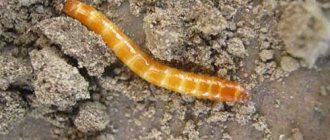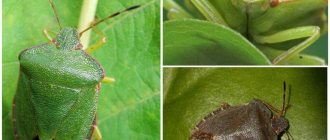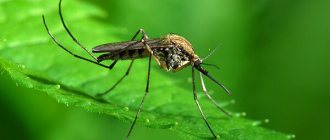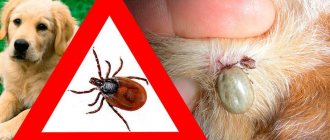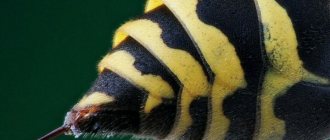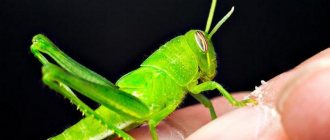Click beetles are a fairly large family in the order of beetles. Scientists have described more than 10 thousand species, which, after detailed study, were combined into 400 genera. The click beetle got its name for the characteristic click-like sound it makes when moving or trying to roll over from its back to its paws.
Click beetles are pests
These beetles live everywhere - from the Arctic to the tropics. They differ in color. In cold regions, dark beetles are found: black, brown with a metallic tint, striped. In the tropics and subtropics there are bright species of click beetles, displaying colors from red to green. Russia is home to steppe click beetles - dark, striped beetles that are pests of vegetable gardens. Next we will talk about them.
What are the main characteristics of the click beetle?
The sound made by the click beetle is not the only characteristic of this insect. Most of these beetles have an oblong body and a head that occupies a third of the length of the entire insect. Its larvae have an oblong, elongated shape, for which they were popularly nicknamed wireworms. The click beetle has a body size of within two centimeters. The main characteristics are given in the table.
| Options | General, uniting | Distinctive |
| Ways to move | ||
| Body Shape | The oblong head occupies a third of the body. Adults have wings and are capable of flight. All click beetles are endowed with a special mechanism that helps them turn over from their backs onto their paws. There are three pairs of paws with which they move on the ground and plants. | Sizes vary from 0.1-6 cm. |
| Dimensions | The sizes of different types vary from 0.1-6 cm. | |
| Color | The coloring of different species is different. Some of them have a pattern in the form of spots on the back. Tropical beetles have a bright color. | |
| Reproduction | Laying of eggs from which larvae are formed. The female never lays all her eggs in one place. One clutch contains 5-7 eggs. In everyday life, the larvae are called wireworms for their elongated body shape, divided into 13 members. The development of the click beetle larva lasts 3-5 years, depending on living conditions. | The larvae of individual click beetle species vary in color and size. |
| Spreading | These insects can be found everywhere, from the subarctic to the tropics. Only tropical species have been studied to a lesser extent than the inhabitants of northern latitudes. | According to the place of distribution and habitat. For example, true click beetles (Ampedus) live in forests. Nutcrackers prefer fields and vegetable gardens. |
| Protection from enemies | Does not use wings. Sensing danger, it begins to jump, click, and tries to carry its legs away. | |
| Nutrition | These beetles differ in the feeding of their larvae. Ampedus are predators. Nutcrackers are phytophagous and are pests of agricultural crops. |
Where are beetles found and what do they eat?
Click beetles love to eat any root vegetables, their favorite delicacy is potatoes, but parasites multiply in any land where there is any vegetation. Wireworms do not disdain weeds, they even lay their eggs on them (burdock, wheatgrass). The formed larva moves to the upper layers of the soil, where there is a sufficient amount of moisture and nutrients.
In the apartment, some may notice adult individuals that have entered through open windows. Immediately destroy the parasite and prevent egg laying. Parasites love to live in food supplies and actively feed on potatoes. It is important to remove spoiled root vegetables in a timely manner.
What does a beetle eat?
Most click beetles are omnivores. In Russia, steppe click beetles live - dark beetles that are pests of vegetable gardens. They especially love potatoes and other root vegetables. The striped click beetle prefers cereals and sunflowers. The small beetle also feeds on the roots of cereals and sunflowers, indulges in the pleasure of sugar beets and peanuts, and eats swollen seeds and seedlings, thereby reducing agricultural yields. The blood-spotted click beetle prefers pine and birch roots.
These beetles cause serious damage to many trees.
Who is the wireworm (larva of the click beetle): what it looks like and why it is dangerous
Wireworms are the larvae of the click beetle (also sometimes called the wireworm). This beetle received this name because if you catch it and turn it on its back, and then slightly touch it with a finger or a twig, it begins to make sounds similar to clicks. The beetle is practically not dangerous, unlike its larva, whose lifespan can reach 3-4 years.
You can see what the click beetle and its wireworm larva look like in the photo below:
The life cycle of the click beetle and its wireworm larvae consists of the following stages of development:
- With the onset of warmth, around the end of April, the beetles, which had previously spent the winter in the ground at a depth of about 20 centimeters, begin to wake up and come to life.
- The adults mate and the females begin laying eggs (up to 200 eggs), from which tiny larvae (3-4 mm) emerge after 3-4 weeks.
- To satisfy their hunger and gain weight, the larvae begin their race in the soil in search of food, eating up and destroying the thin roots of weeds. Therefore, weeds should not be allowed to grow in the garden.
- The next year, the larvae grow to 12-15 mm, and their bodies become tougher.
- At the 3rd year of life, they become completely tough (hence the name - wireworms) and can already penetrate root crops, gnawing holes in them.
- The larvae pupate and develop into adult click beetles.
What kind of root crops are not damaged by this underground pest: potatoes , carrots (although, as a rule, these are the larvae of carrot flies ), beets , onions . In addition, he can even eat young spruce .
Where does the beetle live?
Adults live openly. They can be found on trees, shrubs, and grass. Sometimes they hide in the bark of trees. Eggs are laid in the ground, so digging up the soil in autumn after the harvest is considered an effective method of combating nutcrackers and other pests living in the soil. Sometimes nutcrackers drop into houses (especially in rural areas). If you see an oblong beetle in a house, it should be destroyed immediately, as it does not disdain human food.
The woolly click beetle lives in fields and meadows. It is harmless, on the contrary, it is useful because it pollinates plants.
Description of the parasite
All types of wireworms that live on the planet differ in their size and appearance.
In our region there are steppe beetles, richly dark in color with pronounced stripes. It is quite difficult to confuse the click beetle with other types of insects. The main characteristic of a wireworm is the peculiar sound it makes when jumping. An adult can reach two centimeters in length. The tulub is elongated with a rather large head. The color of the wireworm can be black, brown or with a purple tint.
A female click beetle can lay up to 1,500 eggs. For their safety, there are no more than five in each hole. Eggs are laid in the spring. It will take five years for each of them to develop into an adult. In the first year of life, young insects are absolutely safe. They begin to eat root crops only from the next season.
The click beetle (wireworm) affects:
- potato;
- carrots;
- beets;
- radish;
- Jerusalem artichoke;
- kohlrabi cabbage;
- celery.
Also, this type of insect prefers to feed on succulent shoots of plants and their root system. Click beetles also do not disdain some types of weeds. They lay their eggs in their roots.
A good method of controlling wireworms is marigolds.
The main reason for the appearance of the parasite on the site is plants that are already infected with this insect. If at least one wireworm beetle was noticed in the garden bed, you should definitely start destroying them. Otherwise, most of the harvest will simply be ruined.
How is the agricultural method used?
Agrotechnical methods of combating the click beetle mean:
- digging up the earth in autumn and winter;
- alkalization of soils by adding ash or lime;
- It is recommended to place potato crops in the new year in areas where legumes grew a year ago.
Ash helps remove beetles.
Frequent weeding of the beds gets rid of not only weeds, but also pests.
In order to reduce the number of click beetles, baits made from cut potatoes are laid out in greenhouses before planting. Baits must be checked regularly and any larvae that have entered the potatoes must be destroyed.
Spicy plants such as mustard, rapeseed, oilseed radish, as well as sweet clover, peas, and spinach repel the beetle.
When planting potatoes, it is recommended to plant beans every three bushes, which nutcrackers also do not favor. You can scatter onion peels under the potatoes, and before planting the potatoes, wash the tubers with onion broth.
Fighting methods
Larvae and adults can be destroyed using different methods. The desired result occurs faster when combining several.
Agrotechnical control methods
They are highly effective and long-lasting, but you will have to wait a year or even more for the results.
- In late autumn, dig up the soil. The larvae and eggs that are at the top die from the low temperature.
- During the growing season of plants in sunny weather, the soil should be loosened. The larvae do not tolerate high temperatures and die. The same thing happens with wireworm eggs.
- You should not plant a crop for two years in a row in the same place; you must follow the rules of crop rotation. Legumes and buckwheat will help get rid of the nutcracker in potatoes. When planting potatoes, beans are planted every 3 bushes.
- If the land remains empty for a year, it is recommended to plant it with buckwheat and peas. From such crops, all the wireworms will crawl to neighboring areas.
- One of the most effective ways to combat wireworms is to reduce the acidity of the soil. Mineral fertilizers, ash, slaked lime, chalk, and eggshells are added to the soil.
- When planting potatoes, onion peels are thrown into the holes, and mustard powder is poured between the rows of beds with beets and carrots.
- Marigolds will help scare away the nutcracker from the area if you plant them around the perimeter of the garden, between the beds.
- A few weeks before sowing, oats and barley are planted, then they are removed.
Fighting wireworms
It is imperative to remove weeds and periodically loosen the soil. If it is difficult to control with agricultural methods, you can use insecticides, then follow preventive measures to prevent re-contamination of the soil.
Chemical methods
In the garden, potatoes suffer from wireworms more than other crops. Insecticidal preparations are used to treat the soil, planting material, and green parts of the plant.
- Prestige. A poison with a broad spectrum of action and a long-lasting effect. The solution is prepared immediately before use. For 10 liters of cold water you will need 10 ml of the drug. Stir thoroughly for 10 minutes. Potatoes are treated in the solution, allowed to dry, and planted in holes. The poison lasts 50 days, after which the insecticide is broken down and neutralized in the soil. In Prestige you can also soak the roots of plants and seedlings before planting them in open ground or greenhouses.
- Aktara. A universal remedy for many agricultural pests. Used for spraying the green part of the plant and cultivating the soil. The solution is extremely simple to prepare. 10 ml of concentrate should be dissolved in a bucket of cold water. Stir thoroughly. Water the holes before planting potatoes, beets, and seedlings. 10 liters of solution is enough to treat 10 square meters. m. garden. The poison is neutralized after 60 days.
- Taboo. An insectoacaricidal agent is used to treat seed material and seeds. Apply immediately before planting. 10 ml of product are diluted in 1.5 liters of water. This amount is enough to process 125 kg of seeds.
On a note!
You can destroy the beetles with any poison by spraying the green part of the plant. Traps will help reduce the number of click beetles. The simplest ones are placing half-liter cans or plastic bottles with the neck cut off on the site. To make it more difficult for the nutcracker to get out, lubricate the trap with vegetable oil. To attract pests, pieces of carrots and potatoes are thrown to the bottom.
You can meet the click beetle in an apartment. If the house does not store supplies of vegetables and cereals, there is nothing wrong with the appearance of wireworms. He will crawl away on his own or die of hunger. Otherwise you will have to fight him. The main method is to carry out general cleaning and spray the infected area with an insecticide-based aerosol. The cereal will have to be thrown away.
What chemicals are allowed?
The larvae of the click beetle (wireworms) die when ammonia and potassium fertilizers are added to the soil. For example, ammonium sulfate, which serves as a fertilizer for plants, is toxic to these insects. Treating the wells with a solution of potassium permanganate (potassium permanganate) also gives good results.
To fight, you can use a remedy called Gaucho
Seed dressing also has a good effect. Approximately 2 weeks before the main planting of crops, seeds treated with one of the following products (Gaucho, Taboo, Cruiser, Prestige) are added to the soil. The larvae eat the poisoned seeds and die.
At the larval stage, the click beetle dies when exposed to ammonia and potassium forms of fertilizers. A consistently toxic result for insects is achieved by applying ammonium sulfate in the spring at a rate of 25 g per m². Seedlings can be protected by pre-treating the planting hole with a weak solution of potassium permanganate.
Reproduction and stages of development of beetles
Males of almost all species of beetles are aggressive towards each other and fight among themselves for places rich in food. And during the mating season, the beetles organize real battles for the right to possess the female.
The mating process depends on the genus and species, as well as the lifestyle of the beetles.
Coleoptera belong to higher insects, therefore their life cycle occurs with complete transformation, which implies the sequential passage of 4 stages in development: eggs, larvae, pupae and adults.
In some species, as an exception, this process may have a greater number of phases due to an increase in the number of larval transformations.
Egg
The female beetle lays fertilized eggs in secluded places, which can be used as fallen leaves, nests of insects of other species, stone ruins, deep cracks in the bark of a tree, tunnel systems specially dug in the ground, leaves rolled into a tube, etc. Oval or rounded-oblong eggs of beetles are colored white, gray, greenish, yellowish, grayish-yellow and covered with a thin chitinous or leathery shell. Their size and number depend on the species of the insect. The average duration of the egg stage ranges from 2 to 3 weeks.
Larva
The appearance and color of Coleoptera larvae are very diverse. The larvae of beetles that live in the soil layer or under the bark of a tree are colored yellowish, whitish or pinkish, while the larvae that feed on the surface have brown, black, dirty green outer coats, often with red, yellow or brown spots. The beetle larva looks like this: the body can be worm-like, fleshy, slightly flattened and elongated, with or without well-developed legs, covered with chitinous protective coverings or without them. However, all beetle larvae have a head protected by hard coverings and a gnawing type mouthparts. During the growth process, the beetle larva goes through several molts.
The duration of the stage depends on the species, the type of its nutrition and climatic conditions and can take from several months to 6 years. Some families are characterized by the possibility of puberty and reproduction already at the larval stage, and in representatives of some species, the development of a fertilized egg takes place in the mother’s oviduct until the appearance of mature larvae.
Doll
Almost all Coleoptera, regardless of their habitat, spend the period of transformation into an adult at a depth of up to 20 cm below the soil surface. Although some species of beetles pupate at the sites where the larvae develop. Before the process begins, the larvae arrange a kind of cradle for themselves, in which they spend the entire transformation period, which lasts up to three weeks. During this time, an adult insect grows from the pupated larva.
Imago (adult)
An adult beetle, depending on the species, can live from several months to several years. Many species of beetles die after the mating season and laying eggs, although some adults calmly endure several winterings and re-participate in the reproduction process.
How to make traps
Amateur gardeners came up with such a trap for a malicious pest. Take a liter plastic bottle. The neck with a small part of the body is cut off. A stopper is not needed. The inverted neck is inserted into the lower part of the bottle, where a little beer was previously poured (for the smell). To prevent large and beneficial insects and small frogs from falling into the trap, a stopper nail should be inserted immediately under the neck. Wireworms will freely crawl under the nail into the neck and plop down into the bottom of the bottle, right into the beer, and they won’t be able to get out of there. Several similar traps can be placed at some distance from each other, sprinkled lightly with earth. To prevent the beer from leaking out, it is recommended to lift the trap at a slight angle.
You will learn more about click beetles from the video:
Chemists synthesized female pheromones. This substance attracts males for reproduction. A capsule with a pheromone is placed on a sticky trap, where the males are caught. Thus, the fertility of beetles in the area decreases, and accordingly, the laying of eggs and the appearance of larvae decreases.
Description
An adult click beetle is a medium or large-sized insect, the body length of which varies between 1-75 mm. Its body is flattened and oblong. The elytra are quite hard; in most cases, dotted grooves can be seen on them; as a rule, they have a metallic sheen. The color of click beetles can be different and depends on the subspecies of the insect - some have a uniform black or brown body, while others have a pattern made up of colored spots, stripes or patterns on the pronotum and elytra. There are also tropical species, the color of which is the brightest - the body of such insects is painted in catchy satin shades: orange, red, yellow, blue, green, etc.
As you can see in the photo, the body of the click beetle is covered in places with small hairs and scales. The head, which occupies approximately a third of the body, is retracted into the pronotum. It has a pair of small round eyes and antennae, each of which is divided into 11 segments. The wings are well developed. There are three pairs of long legs, all of the walking type, with claws on the paws. A special feature of the click beetle is the process formed by the mesothorax and prothorax. This is a kind of jumping mechanism that allows the insect to roll over at the right moment. When the beetle turns its back to any surface, it arches the prothorax and places emphasis on the pronotum. In this position, the jumping process comes into readiness. The click beetle sharply bends the prothorax in the other direction, due to which the process strikes the base of the elytra, thus throwing the body upward. The insect, once in the air, performs a somersault and lands on its feet.
Larva
At the larval stage, the click beetle, or more precisely the wireworm, looks like a caterpillar. Its elongated, flattened body is divided into 13 segments of identical structure, which differ only slightly in size. The body has a cylindrical shape. The integument is highly sclerotized, its shape is usually wrinkled and dotted. More often the body is practically naked, but sometimes there are larvae whose bodies are densely covered with small hairs. On the head capsule the chitinous cover is the densest and darkest. The head has the shape of a quadrangle, somewhat narrowed in the front.
There are antennae on the head, each of which consists of three segments. In the anterior part there are powerful mandibles, represented by mandibles - the lower jaws, and maxillae - the upper jaws.
The wireworm larva has three pairs of legs, all equally developed.
Over time, as the insect grows and develops, the body of the insect is covered with weak chitin, colored white, beige or muted yellow. At this time, the wireworm larva becomes a pupa. Thin processes appear at the corners of the pronotum during this period.
Types of click beetles and their descriptions
The following species of click beetles are found in the CIS:
- sch. dark,
- sch. striped,
- sch. brilliant,
- sch. sowing,
- sch. wide.
- sch. Siberian,
- sch. steppe.
The first five species are very widespread and are found in all zones. To identify the click beetle, you need to know the photo and description of the adult individuals.
Dark Nutcracker
Body 7-10 mm long, dark brown in color. The pronotum is swollen, wider than long. Yellow-gray hairs are visible on the elytra.
Striped click beetle
Length 8-11 mm. Color ranges from light brown to dark brown. All parts of the body are punctured, i.e. covered with numerous dots. The length and width of the pronotum are approximately equal.
brilliant nutcracker
Large beetle, 12-15 mm long. The upper part of the body is dark green, shiny, with a bronze tint, the lower part is black. The pronotum is longer than wide. Legs red or black.
Nutcracker sativum
Body length 6-9 mm. the body is black-brown, the antennae and paws are red. The head is convex, covered with a dotted pattern. The body is covered with thick gray hairs.
Nutcracker wide
The body length can reach 16 mm and the width is 4.5 mm. The color is black with a bronze, dark green or dark blue tint. The body is covered with gray hairs. Legs dark brown.
This is also interesting: How to deal with wireworms in potatoes?
Prevention
- Every year in spring and autumn it is recommended to dig up the soil on your site to the maximum depth. In the raised lumps, weed roots, sticks, and wireworms also fall to the surface and die in sunlight and heat (summer) or frost (winter);
- It is necessary to regularly weed the area to clear it of weeds and their roots. We especially love click beetles and their wheatgrass larvae. If this does not help and there is too much grass, you can use chemicals (for example, Roundup) to destroy it;
- You can grow plants with a strong scent, such as marigolds. Its aroma attracts pests, but the sap is poisonous to larvae. You can also alternate the cultivation of crops, for example, after potatoes, plant legumes and soybeans. Their roots are inhabited by special bacteria that release nitrogen into the soil. This leads to alkalization of the soil (reduces acidity) and has a detrimental effect on pest larvae.
